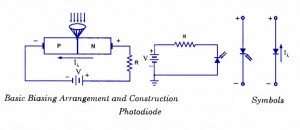
Photo-diode is a two-terminal semiconductor P-N junction device and is designed to operate with reverse bias. The basic biasing arrangement, construction and symbols for the device are given in figure. It is either mounted in translucent case or has its semiconductor junction mounted beneath an optical lens. The output voltage is taken from across a series-connected load resistor R. This resistance may be connected between the diode and ground or between the diode and the positive terminal of the supply, as illustrated in figure.
When the P-N junction is reverse-biased, a reverse saturation current flows due to thermally generated holes and electrons being swept across the junction as the minority carriers. With the increase in temperature of the junction more and more hole-electron pairs are created and so the reverse saturation current I0 increases. The same effect can be had by illuminating the junction. When light energy bombards a P-N junction, it dislodges valence electrons. The more light striking the junction the larger the reverse current in a diode. It is due to generation of more and more charge carriers with the increase in level of illumination. This is clearly shown in ‘ figure for different intensity levels. The dark current is the current that exists when no light is incident. It is to be noted here that current becomes zero only with a positive applied bias equals to VQ. The almost equal spacing between the curves for the same increment in luminous flux reveals that the reverse saturation current I0 increases linearly with the luminous flux as shown in figure. Increase in reverse voltage does not increase the reverse current significantly, because all available charge carriers are already being swept across the junction. For reducing the reverse saturation current I0 to zero, it is necessary to forward bias the junction by an amount equal to barrier potential. Thus the photodiode can be used as a photoconductive device.
On removal of reverse bias applied across the photodiode, minority charge carriers continue to be swept across the junction while the diode is illuminated. This has the effect of increasing the concentration of holes in the P-side and that of electrons in the N-side But the barrier potential is negative on the P-side and positive on the N-side, and was created by holes flowing from P to N-side and electrons from N to P-side during fabrication of junction. Thus the flow of minority carriers tends to reduce the barrier potential.
When an external circuit is connected across the diode terminals, the minority carrier; return to the original side via the external circuit. The electrons which crossed the junction from P to N-side now flow out through the N-terminal and into the P-terminal This means that the device is behaving as a voltage cell with the N-side being the negative terminal and the P-side the positive terminal. Thus, the photodiode is & photovoltaic device as well as photoconductive device.
Photodiodes have a far lower light sensitivity than cadmium sulphide LDR s, but giving a fair quicker response in light level. Generally LDRs are ideal for use in slow acting direct coupled light-level sensing applications, while photodiodes are ideal for use in fast acting ac coupled signalling applications. Typical photodiode applications include detection (both visible and invisible), demodulation, switching, logic circuits that need stability and high speed, character recognition, optical communication equipment, IR remote control circuits encoders etc.

Comments are closed.